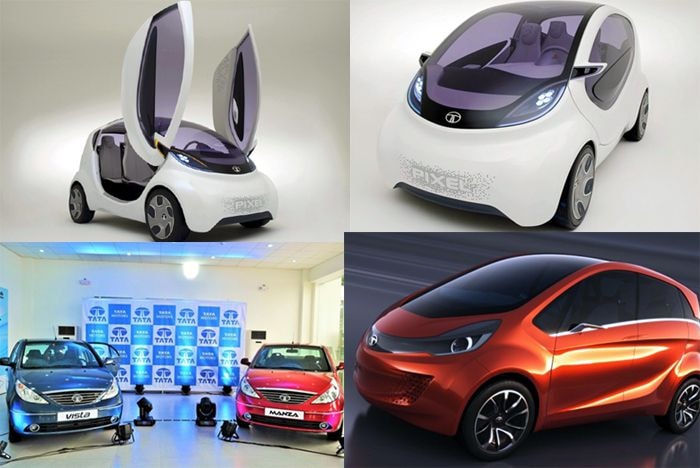100 million car: Cheapest in the world, hard to live in Vietnam?
The handshake between Tata Motors India and Vietnamese companies opens up the opportunity for Vietnamese people to own cheap cars, from only 2,500-5,000 USD. However, will this Indian car make the same mistake as many other cheap cars in Vietnam?
Price just under 200 million VND
From next August, Tata will authorize distributors in Vietnam to import commercial vehicles (buses, trucks, etc.), then 2-16 seat passenger cars. This information is of great interest to many people, especially in the low-cost passenger car segment.
Tata currently has a number of low-cost car models, such as the Zest sedan and Bolt hatchback, priced at around VND135-160 million. Notably, among them is the Tata Nano, the cheapest car in the world, priced from USD2,500-5,000.
According to calculations by Tata Motors' distributor, assembler and technology transferor in Vietnam, this type of car, if it arrives in Hanoi, will cost just under 10,000 USD.
India is a country with many new low-cost car models with attractive designs, including many models equipped with modern features like high-end cars and are aiming to export to other countries, including Vietnam.
 |
| Without any breakthrough, Tata cars are unlikely to generate good sales in the market and become successful. |
For example, Honda has the 7-seat Mobilio model, priced from only 10,800 USD, about 230 million VND; Renault has the Pulse model priced at only about 173 million VND; Hyundai has the Elite i20, priced from 8,000 USD, equivalent to 170 million VND; Toyota has the Etios Liva, priced from 7,750 USD and 9,350 USD,...
Car imports from India to Vietnam are increasing rapidly, especially low-cost cars. However, with brands that are popular with Vietnamese people such as Hyundai, Honda, Toyota, etc., there is no debate, but with the Indian brand Tata, nothing is certain. Many people ask: will Tata follow the "footsteps" of previous low-cost Chinese car brands?
The dismal failure of cheap cars
Among the cheap cars imported to Vietnam, the most notable is the Chinese Chery QQ3 model. In 2009, this model was imported to Vietnam with a price of about 195 million VND and holds the record as the cheapest car today.
The product is quite interesting, with a surprisingly low price from the Chinese car company, which seemed to make the already crowded small segment more exciting. But it turned out to be a disaster.
In 2012, Cherry QQ3 sold 146 units, but in the first 8 months of 2013, only 1 unit was sold. Since then, no more units have been sold. Of course, it is difficult to find a Chery QQ3 on the street. It seems that this model has disappeared without a trace.
Next is the BYD F0 model, also made in China, imported to Vietnam in 2010, priced at 252 million VND for the standard version and 282 million VND for the premium version.
In China, this is a car brand that has developed quite strongly, with the expectation of dominating the low-cost segment of the Vietnamese car market. Since its introduction to distribution, 7 dealerships have been opened at the same time, stretching from North to South. However, in reality, not many F0s have been sold. The expectation of BYD F0 for the taxi market has also become dim.
A BYD car distributor has given up, sharing that the failure was due to the difficulty of selling BYD cars and the high warranty costs. At first, the number of cars sold was acceptable thanks to the car's design being identical to the Toyota Yago model but the price was only 1/3. Only one year later, the rate of cars with problems under warranty that needed maintenance increased rapidly, causing costs to increase, while they received almost no support from the parent corporation. After nearly 3 years of sluggish sales and many problems, this unit stopped distributing new cars and all after-sales support activities.
Another product also from China is Cherry Riich M1. Available on the market since June 2010, this cheap hatchback model is intended to compete with Kia Morning and Chevrolet Spark. With a price of about 288 million VND, after more than 4 years of selling over 50 cars and sales are decreasing, by July 2014 only 2 cars were sold. This is probably the most miserable failure in the cheap small car segment in Vietnam.
Is Tata falling into the same rut?
Previously, at the end of 2012, a Vietnamese company temporarily imported two Tata Nano cars to introduce to dealers and survey customers with the aim of distributing this product.
In early 2014, Tata launched the Nano Twist with many modern features, priced at about 4,000 USD. If imported to Vietnam, it would cost about 10,000 USD.
In fact, Tata Nano has not been successful in any market, even in India where consumers are quite easygoing. Many opinions say that Nano's 0.6L engine is even worse than many motorbikes and cannot run well on highways or mountain passes. Therefore, Nano is not the model that customers expect. Obviously, concerns about the quality of a car that is as expensive as a high-end motorbike and the after-sales story will certainly make customers consider a lot before deciding.
Many people doubt that without any breakthrough, Tata's car models will hardly be able to bring good sales in the market and create success. Tata also realizes the problem and is making changes.
Tata's representatives said that Tata would essentially produce more expensive Nanos, priced on par with competitors, such as the 2011 Tata Pixel concept. But nearly four years on, this has yet to materialize.
According to VnExpress






